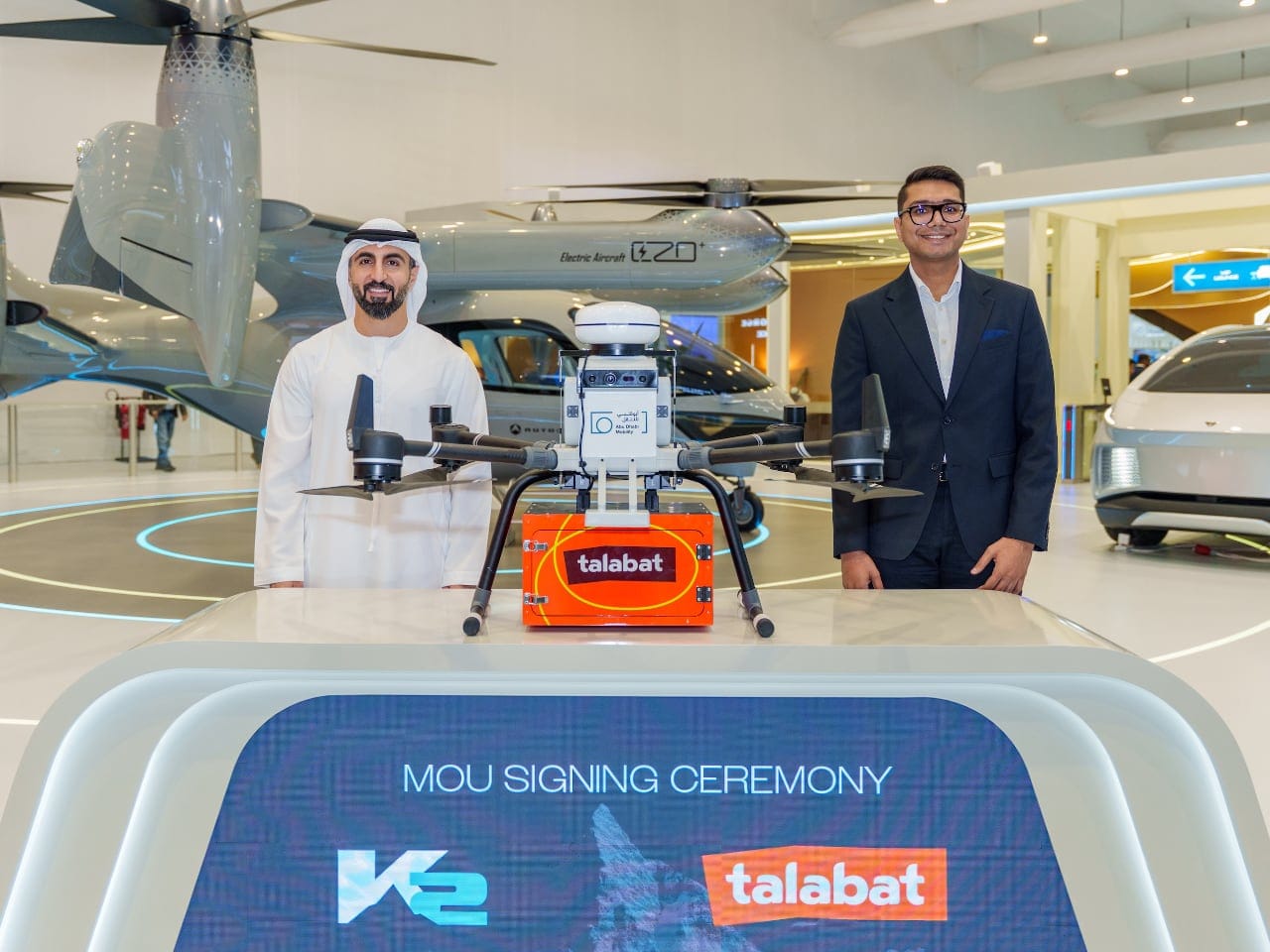Talabat is not done tweaking how your mandi or burger arrives. The food delivery giant has signed a Memorandum of Understanding (MoU) with Abu Dhabi Government-owned advanced technologies company K2 to pilot drone delivery for food and groceries in the UAE. The focus: a “drone-to-station” model that uses drones to move orders to local hubs, where Talabat riders handle the last stretch to your doorstep.
On paper, it’s about faster deliveries and fewer emissions. In practice, it’s also about testing how autonomous systems fit into everyday life in cities like Abu Dhabi and Dubai, where regulators are already sketching air lanes for drones and air taxis.
- Talabat and Abu Dhabi-based K2 have signed an MoU to pilot drone delivery for food and groceries in the UAE.
- The pilot will test a “drone-to-station” model instead of dropping orders straight at your door.
- The partnership aims to boost delivery speed, cut operational emissions, and ease pressure on riders in high-demand areas.
- Talabat is positioning this as part of its push into smarter, more autonomous last-mile logistics after its DFM listing.
- K2 will plug drone delivery into its wider smart-city and autonomous mobility ecosystem in Abu Dhabi.
What Talabat and K2 are actually doing
This is a pilot, not a full commercial rollout. The MoU gives both companies room to experiment with how drones fit into the existing delivery network.
- Talabat will use the pilot to test autonomous delivery for food and groceries.
- K2 will integrate drone delivery into its wider smart-city and autonomous mobility stack.
- The model focuses on drones flying between stations, not straight into residential balconies.
- Both sides say the goal is to improve efficiency, safety, and sustainability.
Talabat brings the scale: a regional delivery platform with millions of active customers across MENA and thousands of restaurant and grocery partners. K2, meanwhile, is an Abu Dhabi Government-owned advanced technologies company working across robotics, autonomous mobility, and performance science. That mix makes this less of a stunt and more of a live test for how drones can plug into real-world demand rather than controlled demos.
If you’ve been following Talabat’s recent moves – like its new rider wallet partnership to improve payouts and safety for riders – this fits a broader pattern of trying to make last-mile logistics more digital and data-driven, not just faster.
How the drone-to-station model works
This is not “drone drops shawarma on your balcony” (yet). The pilot will test a drone-to-station model, which is more realistic for dense urban areas.
- Drones will likely fly between predefined hubs or stations.
- Riders or other couriers handle the final leg from station to customer.
- The model targets high-demand or high-traffic zones where road congestion is worst.
- The aim is to speed up peak-time delivery and reduce load on road-based fleets.
By splitting the journey into air and ground legs, Talabat and K2 can test drone routes without needing every building to be “drone-ready”. Stations can be placed where it makes operational sense – close to clusters of restaurants, cloud kitchens, or residential communities. Over time, this sort of hybrid model could sit alongside other last-mile options like big-box car deliveries and bike-based fleets already active in the UAE.
For Talabat, this is also about resilience: if drones can take over some middle-mile or trunk routes, the platform is less exposed to road bottlenecks, fuel price swings, or rider capacity constraints during big events and peak seasons.
Why emissions and “smarter” logistics matter
The MoU leans heavily on efficiency and sustainability as key goals. That’s not just PR language; last-mile delivery is one of the messiest parts of the logistics chain for emissions and congestion.
- Drones can bypass road congestion in dense zones.
- Short, optimised air routes can lower emissions per order, especially if powered by cleaner energy.
- Station-based models make route planning more predictable for both drones and riders.
- Better routing and automation can reduce failed deliveries and unnecessary trips.
The UAE is already building out a framework for autonomous vehicles and drones in the sky, from proposed air taxi rules to dedicated test sites in Abu Dhabi. Drone pilots like this put real data behind those policies – from noise and safety to air-traffic coordination – instead of relying only on simulations.
If Talabat and K2 can show that drones cut emissions while keeping – or improving – delivery times, it strengthens the case for regulators to widen these trials and for other players across logistics, retail and e-commerce to follow. For readers who care more about outcomes than acronyms: the goal is fewer vans stuck in traffic and more predictable arrival times on your lunch break.
What this means for customers, riders, and cities
The MoU doesn’t promise a live date when your next shawarma will arrive by drone, but it does hint at how food delivery in the UAE might look over the next few years.
- Customers could see faster delivery windows in specific “pilot” zones.
- Riders might handle shorter, denser routes around drone stations, instead of long cross-town trips.
- Cities gain another data point for how to integrate drones into existing infrastructure.
- The model supports the UAE’s broader push for smart, autonomous mobility and logistics.
For riders, a station-based network could mean more predictable routes, less time stuck in heavy traffic, and clearer break points between trips. That sits neatly alongside financial and safety improvements like digital rider wallets, which are already rolling out in partnership with du Pay.
For cities like Abu Dhabi and Dubai, drone pilots aren’t happening in isolation. They tie into a bigger stack of smart-city projects – from AI-driven traffic systems to smart logistics hubs and autonomous mobility clusters – all trying to make sure that the rush for faster delivery doesn’t clog roads or compromise safety.
And for you as a user? For now, nothing changes in the app. Orders will still show up with the usual rider flow. The difference is that, behind the scenes, part of that journey might soon be flying over your head instead of lining up behind you on Sheikh Zayed Road.
Who are Talabat and K2?
The release also reminds everyone that both companies are playing long games, not just one-off stunts.
- Talabat is the leading on-demand delivery platform in MENA, founded in 2004 in Kuwait.
- It operates across the UAE, Oman, Qatar, Bahrain, Jordan, Iraq, and Egypt with millions of active customers.
- Talabat completed its IPO on the Dubai Financial Market in December 2024.
- K2 is an Abu Dhabi Government-owned advanced technologies company focused on robotics, autonomous mobility, and performance science.
For Talabat, testing drones is part of a broader strategy to push further into technology-driven logistics after listing, while still keeping its delivery app familiar to users. For K2, working with a consumer-facing platform lets its autonomous systems graduate from lab tests to orders people actually care about – groceries, meals, and everyday essentials.
If you want to see where drones are already being pitched as part of the UAE’s delivery future, it’s worth reading our coverage on drone delivery ambitions in Dubai and ongoing work on rules for autonomous air taxis and drones in Abu Dhabi – both of which show how fast this space is moving.
FAQs: Talabat x K2 drone delivery in the UAE
Will my Talabat order be delivered by drone soon?
Not immediately. This is a pilot MoU, which means Talabat and K2 will first test routes, stations, safety, and operations in controlled scenarios and selected areas. There’s no public launch date yet for full drone delivery to homes.
What is a “drone-to-station” delivery model?
Instead of flying directly to your balcony, drones move orders between fixed stations or hubs. Riders or other couriers then handle the last leg from station to your address. This approach is easier to regulate, plan, and scale in dense urban environments than pure door-to-door flights.
Why are Talabat and K2 focusing on drones now?
Both companies frame the pilot around innovation, smarter logistics, and sustainability. Drones could help reduce delivery times in high-demand zones, cut operational emissions and give both firms real-world data on how autonomous systems perform in UAE cities.
How does this affect Talabat riders?
In the short term, riders remain core to the delivery chain. Over time, a drone-to-station model could shift them towards shorter, denser routes centred around stations, supported by existing digital tools like rider wallets and smarter routing. The pilot will help test what actually works for both riders and operations.
Is this linked to UAE drone and autonomous mobility plans?
Yes, even if the release doesn’t spell out every policy. The UAE is already working on rules and testbeds for autonomous air taxis and delivery drones, especially in Abu Dhabi. Pilots like this give regulators and operators real-world feedback on safety, airspace use, and city impact – and help turn “future mobility” from a slide deck into actual services.
Subscribe to our newsletter to get the latest updates and news







